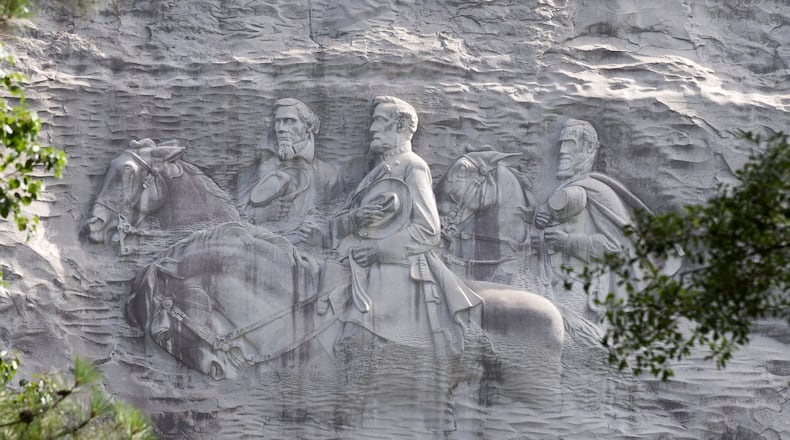In the predawn hours Thursday, an anonymous work crew wearing flak jackets removed the statue of Jefferson Davis from its 13-foot pedestal on Jefferson Davis Parkway in New Orleans — the second monument taken down in the city’s continuing purge of Confederate memorials.
Confederate-flag-waving protesters and pro-removal demonstrators yelled at each other from barricades police erected to separate them. All watched as the workers, their faces obscured, secured the statue to a crane, chiseled its feet off the pedestal and then hoisted it onto a flatbed truck to be hauled away, the Times-Picayune reported.
Opponents of the removal yelled “cowards” and “totalitarianism” as the statue came down, the newspaper said.
In metro Atlanta, the truly in-your-face Confederate memorials tend to be limited to the world’s largest, at Stone Mountain, and the state Capitol.
Joseph Crespino, the Jimmy Carter Professor of American History at Emory University, said the main difference between New Orleans and Atlanta is one of placement.
In Atlanta, “they are all at the Capitol or immediately near it,” said Crespino, who specializes in Southern history since Reconstruction. “In New Orleans, they are all spread out. Lee Circle is a very majestic public space with this big monument in the roundabout. What fueled it in New Orleans was how prominent they were in the city.”
The centerpiece of Lee Circle is a soaring statue of Robert E. Lee. Including the column on which Lee stands, the monument is more than 80 feet tall. It, too, will come down.
Unlike those extravagant displays in New Orleans, most other Confederate monuments and markers in metro Atlanta are in context, such as at Kennesaw Mountain National Battlefield Park or the Marietta Confederate Cemetery. Many Georgians never make it to the Capitol grounds or Kennesaw Mountain.
The Stone Mountain carving, of course, will endure for a very long time, and a move to crown the mountain with a monument to Dr. Martin Luther King Jr., announced with fanfare in 2015, has all but died.
The Stone Mountain Park Association is pressing ahead instead with its plans for a museum dedicated to black Civil War soldiers.
In New Orleans Thursday, the workers removing the Davis statue were contractors in protective gear who had even blacked in their company’s name on their trucks. These were the same procedures followed last month, when the city took down an obelisk that honored the Crescent City White League.
"The city is in the process of determining a more appropriate place to display the statues post-removal, such as a museum or other site, where they can be placed in their proper historical context from a dark period of American history," city spokesman Tyronne B. Walker, told the New York Times on Thursday.
He attributed the strong police presence at the site to “consistent threats, harassments and intimidation tactics” that have greeted the plans to remove the monuments.
New Orleans Mayor Mitch Landrieu said the original removal contractor pulled out after receiving death threats and having one of its cars set on fire. "Nearly every heavy-crane company in southern Louisiana has received threats from opponents," Landrieu wrote in Thursday's Washington Post.
The New Orleans monuments are mostly in well-traveled public places. The Jefferson Davis statue was on Jefferson Davis Parkway at Canal Street in the Mid City district. The Robert E. Lee statue is in the city’s central business district. The massive equestrian statue of Gen. Pierre Gustave Toutant Beauregard is at the entrance to City Park.
The New Orleans City Council authorized the removal of the four Confederate memorials in 2015, not long after a white supremacist massacred nine people at a black church in Charleston, S.C. The removals were delayed while opponents fought the plans in court.
"These monuments have stood not as historic or educational markers of our legacy of slavery and segregation, but in celebration of it," Mayor Landrieu said in a statement Thursday.
"To literally put the Confederacy on a pedestal in some of our most prominent public places is not only an inaccurate reflection of our past, it is an affront to our present, and a bad prescription for our future. We should not be afraid to confront and reconcile our past."
The city isn’t saying when it will dismantle the Lee and Beauregard monuments.
Nor would it disclose the city warehouse where the Jefferson Davis monument ended up.
Keep Reading
The Latest
Featured




